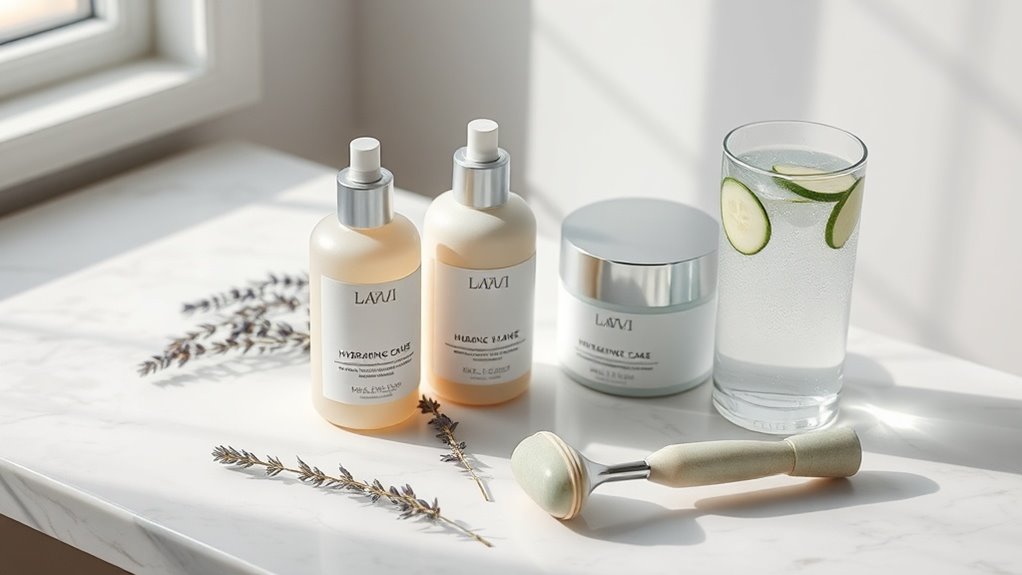Dealing With Both Oily and Dry Skin. Try This Fix
Dealing with both oily and dry skin can be challenging. You might notice shiny areas on your T-zone while experiencing dryness on your cheeks. This combination can complicate your skincare routine, but finding a balance is essential. Understanding your skin’s unique needs is the first step. Let’s explore how to create a tailored regimen that addresses these concerns effectively while maintaining overall skin health.
Key Takeaways
- Identify your skin type by observing oily T-zones and dry patches to tailor your skincare routine effectively.
- Use a gentle foaming cleanser that removes impurities without stripping natural moisture.
- Apply lightweight, non-comedogenic moisturizers on oily areas while using richer creams on dry patches.
- Incorporate a hydrating serum with hyaluronic acid to enhance skin moisture retention.
- Maintain a balanced diet, stay hydrated, and prioritize sleep for overall skin health.
Understanding Combination Skin
Combination skin presents a unique challenge as it exhibits characteristics of both oily and dry skin types. You might notice an oily T-zone, while your cheeks feel dry or tight.
This duality requires a careful approach to skincare.
To fix combination skin, opt for gentle cleansers that don’t strip moisture and lightweight moisturizers that hydrate without clogging pores.
Incorporate exfoliation to remove dead skin cells, focusing on oily areas.
Additionally, consider using spot treatments for breakouts, ensuring they don’t exacerbate dryness elsewhere.
Understanding your skin’s nuances is crucial for achieving a balanced complexion that addresses both oily and dry areas effectively. It’s important to recognize that combination skin often results from a variety of factors, including genetics and environmental influences.
Identifying Your Skin’s Needs
Understanding your skin’s specific needs is vital for effective skincare.
Recognizing your skin’s unique requirements is essential for achieving optimal skincare results.
Start by assessing your skin type: observe areas of oiliness and dryness.
Pay attention to how your skin reacts to different products and environmental factors.
Conduct a patch test when trying new products to identify potential irritants.
Keep track of your skin’s hydration levels, especially in varying climates.
Note any changes related to diet, stress, or hormonal fluctuations. Additionally, knowing your skin type can significantly influence your product choices and help in managing both oily and dry areas effectively.
Tailored Skincare Routine
Creating a tailored skincare routine is essential for addressing the unique needs of both oily and dry skin.
Start by identifying your skin type and its specific concerns.
Incorporate a gentle cleanser to remove impurities without stripping moisture.
For oily areas, consider lightweight, non-comedogenic moisturizers to prevent clogging pores.
In contrast, use richer creams on dry patches to maintain hydration.
Exfoliation should be balanced; opt for chemical exfoliants that target oiliness while being gentle on dry zones.
Lastly, always apply sunscreen to protect against UV damage. Additionally, understanding your skin type can greatly enhance the effectiveness of your skincare routine.
Recommended Products for Balance
Finding the right products can significantly enhance your balanced skincare routine.
To effectively manage both oily and dry areas, consider incorporating these recommended products:
-
Gentle Foaming Cleanser: Removes impurities without stripping moisture.
-
Hydrating Serum: Infused with hyaluronic acid to retain skin hydration.
-
Oil-Free Moisturizer: Provides necessary moisture without clogging pores.
-
Clay Mask: Targets excess oil, balancing your skin’s overall texture.
Using these products consistently will help you achieve a harmonious balance, ensuring that both oily and dry areas of your skin are adequately addressed for a healthier complexion. Additionally, selecting a cleanser based on your specific skin type can further improve your skincare results.
Lifestyle Tips for Healthy Skin
How can your daily habits influence the health of your skin?
Maintaining a balanced diet rich in antioxidants, vitamins, and healthy fats can improve your skin’s condition.
Hydration is crucial; aim for at least eight glasses of water daily.
Regular exercise boosts circulation, delivering nutrients to your skin.
Prioritize sleep; it allows your skin to repair and regenerate.
Avoid excessive sun exposure and always wear SPF.
Manage stress through mindfulness or exercise, as stress can exacerbate skin issues.
Lastly, refrain from touching your face to reduce the risk of breakouts.
Implementing these habits fosters healthier, balanced skin. Additionally, adopting a routine that focuses on combating premature aging can significantly enhance your skin’s overall vitality.




